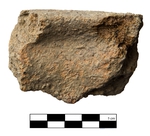Document Content
Conclusion
The goals of CA 78 this season were:
1. To explore the area immediately to the north of CA 70 to CA 74 and reveal new architectural features, stratigraphy, and topographic information in this area.
2. To recover dateable material from a secure context to better understand the features found in 2012 in Civitate A
3. To search for evidence of non-elite habitation on the western area of the hill in association with previous architecture and deposits of the area.
4. To explore the possibility of further metal working in the area associated with the roasting pits in CA 33
CA 78 was partially succesful in achieving its goals this season. We did find more evidence of metal working in the immediate area of CA 78 with fragments of forni (e.g. 20130020 ), crucibles (e.g. 20130208 20130208 ), and slag (e.g. 20130110 ). The trench also had a few items of finished metal in the form of a bronze pin with bone bead and a bronze fibula ( 20130074 and 20130028 ).
CA 78 did recover some fragments of stamped pottery with a typologically earlier triangle stamp type ( 20130186 and 20130262 20130262 , cf. 20090016 ). While the stamp type is not a firm chronological marker it does point to a
possible earlier date of occupation in the area around the time of transition between the late iron age and the early orientalizing period.
CA 78 also partially revealed elements of architecture connected with non-elite habitation on the western part of the hill. In Locus 7 , a line of linear stones appeared that ran north/south for about a meter and then into CA 73. It was in CA 73 that the continuation of the wall became muddled by possible successive phases of occupation in the area. This linear feature may be a non-load bearing wall connected with other features in the area.
Running roughly parallel to the first feature seems to be the northern termination of the robust linear feature that runs from CA 72 through CA 73 and into CA 78. It is a series of parallel rock lines that are packed with large fragments of roofing tiles. The northern terminations of both these rock features has been obscured either by materials being robbed out in ancient times or from erosion due to the slightly higher elevation of CA 78 in
comparison to the rest of the CA 70s trenches. North of this robust feature was also a pocket of soil heavily included by plaster. Almost no other trenches had this type of soil except CA 73, which had a plaster included soil in the robust linear feature. This feature in conjunction with the robust feature in the CA 72 and CA 73 trenches from 2012 seems to form the eastern and western walls of a light framed structure. The lack of tile found in the area points to the possibility that this structure was thatched. While the southern termination seems to be running east/west through CA 76, the northern termination did not clearly appear in CA 78.
Along the northern baulk wall of CA 78, a possible intentionally cut lens into bedrock was exposed. In conjunction with CA 82, the horizontal extent of the lens was exposed along with part of vertical, but the lens was not excavated fully in CA 78, obscuring our understanding of how the inhabitants were using the bedrock north of all the linear rock features.
Also north of these linear features were several artifact rich loci. In locus 12 alone, 872 sherds of pottery and 341 fragments of bone were recovered, the highest count for pottery and bone of all the loci. The fragmentary nature of the artifacts and the types being found seem consistent with artifact assemblages found outside of production spaces at other sites.
All of these conclusions can only be tentatively put forth and further excavation is warranted of the surrounding area to fully understand the features.
| Descriptive Attribute | Value(s) |
|---|---|
| Document Type | Trench Book Entry |
| Trench Book Entry Date | 2013-08-11 |
| Entry Year | 2013 |
| Start Page | 339 |
| End Page | 346 |
| Title | Conclusion |
| Descriptive Attribute | Value(s) |
|---|---|
|
Is Part Of
Vocabulary: DCMI Metadata Terms (Dublin Core Terms) |
AJC V
Vocabulary: Murlo |
Suggested Citation
Andrew J. Carroll. (2017) "AJC V (2013-08-11):339-346; Conclusion from Europe/Italy/Poggio Civitate/Civitate A/Civitate A78/2013, ID:663". In Murlo. Anthony Tuck (Ed). Released: 2017-10-04. Open Context. <https://opencontext.org/documents/f8b715d5-3b5d-48a6-af33-d79c964b9d11> ARK (Archive): https://n2t.net/ark:/28722/k2xk8m49g
Copyright License
To the extent to which copyright applies, this content
carries the above license. Follow the link to understand specific permissions
and requirements.
Required Attribution: Citation and reference of URIs (hyperlinks)






























